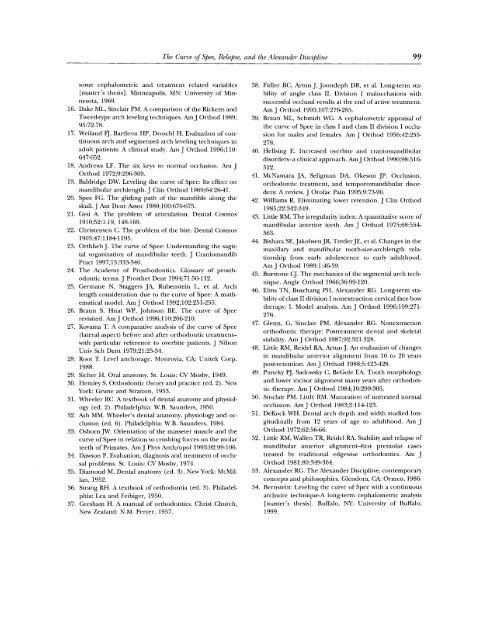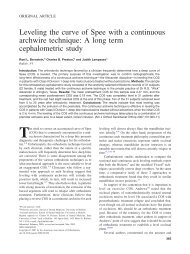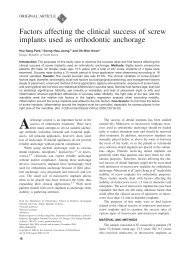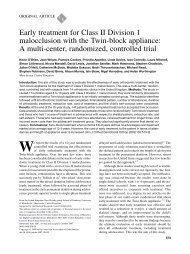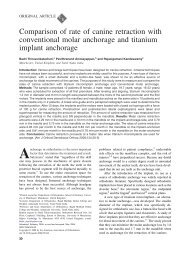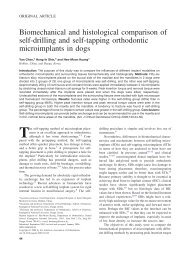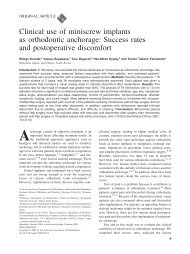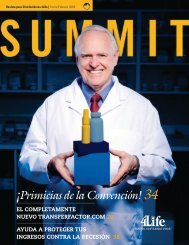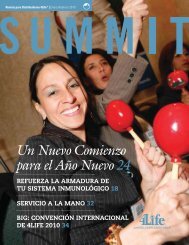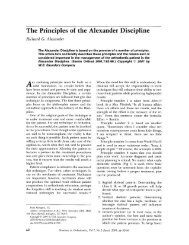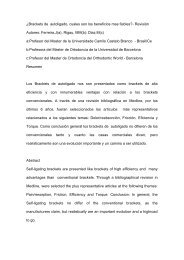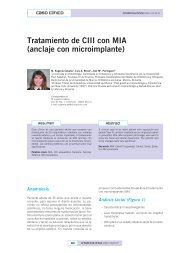The Relationship Between the Curve of Spee ... - ResearchGate
The Relationship Between the Curve of Spee ... - ResearchGate
The Relationship Between the Curve of Spee ... - ResearchGate
You also want an ePaper? Increase the reach of your titles
YUMPU automatically turns print PDFs into web optimized ePapers that Google loves.
some cephalometric and treatment related variables<br />
[master's <strong>the</strong>sis]. Minneapolis, MN: University <strong>of</strong> Min-<br />
nesota, 1969.<br />
16. Dake ML, Sinclair PM. A comparison <strong>of</strong> <strong>the</strong> Ricketts and<br />
Tweed-type arch leveling techniques. AmJ Orthod 1989;<br />
95:72-78.<br />
17. Weiland FJ, Bartleon HP, Droschl H. Evaluation <strong>of</strong> con-<br />
tinuous arch and segmented arch leveling techniques in<br />
adult patients: A clinical study. Am J Orthod 1996;110:<br />
647-652.<br />
18. Andrews LF. <strong>The</strong> six keys to normal occlusion. Am J<br />
Orthod 1972;9:296-309.<br />
19. Baldridge DW. Leveling <strong>the</strong> curve <strong>of</strong> <strong>Spee</strong>: Its effect on<br />
mandibular archlength. J Clin Orthod 1969;64:26-41.<br />
20. <strong>Spee</strong> FG. <strong>The</strong> gliding path <strong>of</strong> <strong>the</strong> mandible along <strong>the</strong><br />
skull. J Am Dent Assoc 1980;100:670-675.<br />
21. Gysi A. <strong>The</strong> problem <strong>of</strong> articulation. Dental Cosmos<br />
1910;52:1-19, 148-169.<br />
22. Christensen C. <strong>The</strong> problem <strong>of</strong> <strong>the</strong> bite. Dental Cosmos<br />
1905;47:1184-1195.<br />
23. Orthlieb J. <strong>The</strong> curve <strong>of</strong> <strong>Spee</strong>: Understanding <strong>the</strong> sagit-<br />
tal organization <strong>of</strong> mandibular teeth. J Craniomandib<br />
Pract 1997;15:333-340.<br />
24. <strong>The</strong> Academy <strong>of</strong> Prosthodontics. Glossary <strong>of</strong> prosth-<br />
odontic terms. J Pros<strong>the</strong>t Dent 1994;71:50-112.<br />
25. Germane N, Staggers JA, Rubenstein L, et al. Arch<br />
length consideration due to <strong>the</strong> curve <strong>of</strong> <strong>Spee</strong>: A math-<br />
ematical model. AmJ Orthod 1992;102:251-255.<br />
26. Braun S, Hnat WP, Johnson BE. <strong>The</strong> curve <strong>of</strong> <strong>Spee</strong><br />
revisited. Am J Orthod 1996;110:206-210.<br />
27. Koyama T. A comparative analysis <strong>of</strong> <strong>the</strong> curve <strong>of</strong> <strong>Spee</strong><br />
(lateral aspect) before and after orthodontic treatment-<br />
with particular reference to overbite patients. J Nihon<br />
Univ Sch Dent 1979;21:25-34.<br />
28. Root T. Level anchorage. Monrovia, CA: Unitek Corp,<br />
1988.<br />
29. Sicher H. Oral anatomy. St. Louis: CV Mosby, 1949.<br />
30. Hemley S. Orthodontic <strong>the</strong>ory and practice (ed. 2). New<br />
York: Grune and Stratton, 1953.<br />
31. Wheeler RC. A textbook <strong>of</strong> dental anatomy and physiol-<br />
ogy (ed. 2). Philadelphia: W.B. Saunders, 1950.<br />
32. Ash MM. Wheeler's dental anatomy, physiology and oc-<br />
clusion (ed. 6). Philadelphia: W.B. Saunders, 1984.<br />
33. OsbornJW. Orientation <strong>of</strong> <strong>the</strong> masseter muscle and <strong>the</strong><br />
curve <strong>of</strong> <strong>Spee</strong> in relation to crushing forces on <strong>the</strong> molar<br />
teeth <strong>of</strong> Primates. Am J Phys Anthropol 1993;92:99-106.<br />
34. Dawson P. Evaluation, diagnosis and treatment <strong>of</strong> occlu-<br />
sal problems. St. Louis: CV Mosby, 1974.<br />
35. Diamond M. Dental anatomy (ed. 3). NewYork: McMil-<br />
lan, 1952.<br />
36. Strang RH. A textbook <strong>of</strong> orthodontia (ed. 3). Philadel-<br />
phia: Lea and Feibiger, 1950.<br />
37. Gresham H. A manual <strong>of</strong> orthodontics. Christ Church,<br />
New Zealand: N.M. Peryer, 1957.<br />
<strong>The</strong> <strong>Curve</strong> <strong>of</strong> <strong>Spee</strong>, Relapse, and <strong>the</strong> Alexander Discipline 99<br />
38. Fidler BC, Artun J, Joondeph DR, et al. Long-term sta-<br />
bility <strong>of</strong> angle class II, Division I malocclusions with<br />
successful occlusal results at <strong>the</strong> end <strong>of</strong> active treatment.<br />
AmJ Orthod 1995;107:276-285.<br />
39. Braun ML, Schmidt WG. A cephalometric appraisal <strong>of</strong><br />
<strong>the</strong> curve <strong>of</strong> <strong>Spee</strong> in class 1 and class II division I occlu-<br />
sion for males and females. Am J Orthod 1956;42:255-<br />
278.<br />
40. Hellsing E. Increased overbite and craniomandibular<br />
disorders-a clinical approach. AmJ Orthod 1990;98:516-<br />
522.<br />
41. McNamara JA, Seligman DA, Okeson JP. Occlusion,<br />
orthodontic treatment, and temporomandibular disor-<br />
ders: A review. J Or<strong>of</strong>ac Pain 1995;9:73-90.<br />
42. Williams R. Eliminating lower retention. J Clin Orthod<br />
1985;22:342-349.<br />
43. Little RM. <strong>The</strong> irregularity index: A quantitative score <strong>of</strong><br />
mandibular anterior teeth. Am J Orthod 1975;68:554-<br />
563.<br />
44. Bishara SE,JakobsenJR, TrederJE, et al. Changes in <strong>the</strong><br />
maxillary and mandibular tooth-size-archlength rela-<br />
tionship from early adolescence to early adulthood.<br />
Am J Orthod 1989; 1:46-59.<br />
45. Burstone CJ. <strong>The</strong> mechanics <strong>of</strong> <strong>the</strong> segmental arch tech-<br />
nique. Angle Orthod 1966;36:99-120.<br />
46. Elms TN, Buschang PH, Alexander RG. Long-term sta-<br />
bility <strong>of</strong> class II division I nonextraction cervical face-bow<br />
<strong>the</strong>rapy: I. Model analysis. Am J Orthod 1996;109:271-<br />
276.<br />
47. Glenn, G, Sinclair PM, Alexander RG. Nonextraction<br />
orthodontic <strong>the</strong>rapy: Postreatment dental and skeletal<br />
stability. Am J Orthod 1987;92:321-328.<br />
48. Little RM, Reidel RA, Artun J. An evaluation <strong>of</strong> changes<br />
in mandibular anterior alignment from 10 to 20 years<br />
post-retention. Am J Orthod 1988;5:423-428.<br />
49. Puneky PJ, Sadowsky C, BeGole EA. Tooth morphology<br />
and lower incisor alignment many years after orthodon-<br />
tic <strong>the</strong>rapy. AnlJ Orthod 1984;10:299-305.<br />
50. Sinclair PM. Little RM. Maturation <strong>of</strong> untreated normal<br />
occlusion. AmJ Orthod 1983;2:114-123.<br />
51. DeKock WH. Dental arch depth and width studied lon-<br />
gitudinally from 12 years <strong>of</strong> age to adulthood. Am J<br />
Orthod 1972;62:56-66.<br />
52. Little RM, Wallen TR, Reidel RA. Stability and relapse <strong>of</strong><br />
mandibular anterior alignment-first premolar cases<br />
treated by traditional edgewise orthodontics. Am J<br />
Orthod 1981;80:349-364.<br />
53. Alexander RG. <strong>The</strong> Alexander Discipline, contemporary<br />
concepts and philosophies. Glendora, CA: Ormco, 1986.<br />
54. Bernstein: Leveling <strong>the</strong> curve <strong>of</strong> <strong>Spee</strong> with a continuous<br />
archwire technique-A long-term cephalometric analysis<br />
[master's <strong>the</strong>sis]. Buffalo, NY: University <strong>of</strong> Buffalo,<br />
1999.


